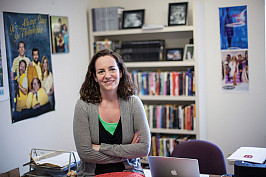
Who Was the Boss?
Q. Your recent research looks at the contradiction between the family values of the 1980s political landscape, and the actually families in network TV sitcoms. Tell us something about the ’80s TV families we remember.
A. Many of us remember the 1980s as a revival of conservative social values, particularly characterized by a backlash against feminism. Some popular media of the time bears this out, perhaps most famously in the 1988 film Fatal Attraction, which pits a traditional wife and mother against a single, independent (and not coincidentally, psychotic) career woman, and in action films that glorify muscular male stars like Arnold Schwarzenegger and Sylvester Stallone. On television, however, particularly family sitcoms, mothers typically worked professional jobs outside of the home, and fathers took on a great deal of household work and childcare. Many of the fathers on these sitcoms worked from home so that could take on more household responsibilities and support their wives’ careers. On Growing Pains and The Cosby Show, the fathers run their medical practices out of their family homes while their wives work as a newspaper reporter and a lawyer, respectively. On My Two Dads, one dad works from home while the other works a traditional office job. There were several popular sitcoms that had their male stars working as housekeepers for single women or families, such as Who’s the Boss?, Mr. Belvedere, and Charles in Charge. The models of femininity and masculinity, especially with respect to household and familial roles, were much more fluid on these sitcoms than in film and politics during the same time period.
Q. Why do you think this gap occurred?
A. While Hollywood film is primarily produced to appeal to a young, white male audience, television has historically targeted a slightly older, white female audience. So while films of the 1980s often seemed engaged with popular anti-feminist rhetoric, television continued to appeal to women, and thus its gender politics were quite a bit different. The television networks were also beholden to advertisers, who wanted to reach an upscale, female consumer. Market research in the mid-1970s and into the 1980s found that women across the occupational spectrum did not respond positively to images of women as homemakers. Women did respond positively to images of men engaged in domestic tasks, which may help to explain the growth in numbers of male television characters who were more involved in household chores. In 1985, the National Commission on Working Women praised “the emergence of men as nurturers” on the fall television schedule. These televisual images of masculinity were clearly a far cry from films like Commando and Rambo, which came out of the same year.
Q. Did this phenomenon lead to any cultural changes in television in the next decade?
A. Yes and no. Television changed so much in the 1990s that it’s hard to say. Many of the 1980s sitcoms continued into the 1990s (Full House ran until 1995, Roseanne ended in 1997), but many of the new sitcoms focused on groups of friends like Seinfeld and Friends, rather than on families. Still, the women in these later sitcoms work and aren’t overly concerned with starting families, so that may be a holdover from the ’80s sitcom career women. We also see an increase in female-driven drama series like Ally McBeal, Alias, and Buffy the Vampire Slayer.
Q. The 1980s were a time of change for television, as you noted. Why was the industry at such a crossroads?
A. The early 1980s were a time of transition for the three networks, ABC, CBS and NBC. Their Nielsen ratings were down, there were a couple of labor strikes and a football strike that briefly crippled the industry, and many of their successful, dependable shows were nearing the end of their runs. The networks needed to both cut costs and attract more advertisers, and family sitcoms did both. They were relatively cheap to produce, they could be sold into syndication on independent stations, and they appealed to women consumers, whom advertisers wanted to reach. Although the explosion of family sitcoms in the 1980s in many ways saved the struggling networks, major changes still lay ahead. The 1980s were the last decade where three networks dominated the television landscape. Fox launched primetime programming in 1987, and cable systems were gaining more and more subscribers throughout the decade. As a result, much of the television industry now operates under a narrowcasting model rather than a broadcasting model. The old, network era broadcasting model sought as large an audience as possible, whereas the current narrowcasting model seeks to appeal to a very particular group of people so that advertisers can supposedly get more bang for their buck. That shift to narrowcasting began in the 1980s and accelerated in the 1990s.
Q. Since you also study reality TV and wrote several articles about this genre, can you offer a comment on whether there is more to these shows than meets the eye?

Q. What do you watch on television?
A. I watch an eclectic mix of shows I’m currently studying, shows I may study in the future, and shows I like, although often “shows I like” become objects of study. I have seen every episode of It’s Always Sunny in Philadelphia multiple times. I also like watching reruns of teen soap operas like Beverly Hills, 90210 and One Tree Hill. My favorite reality shows are Survivor and Project Runway, but I also watch a lot of reality shows on TLC and Keeping Up with the Kardashians for research.
Q. Do friends ask you what looks good in the fall lineup? (And, what does?)
A. Not really! I haven’t started any new shows this season, but I would recommend The Good Wife, which just started its seventh season, and Empire, which just started its second season. I also love The Americans, which will be back on FX next year. It’s set in the 1980s, but that’s not the only reason I love it.


